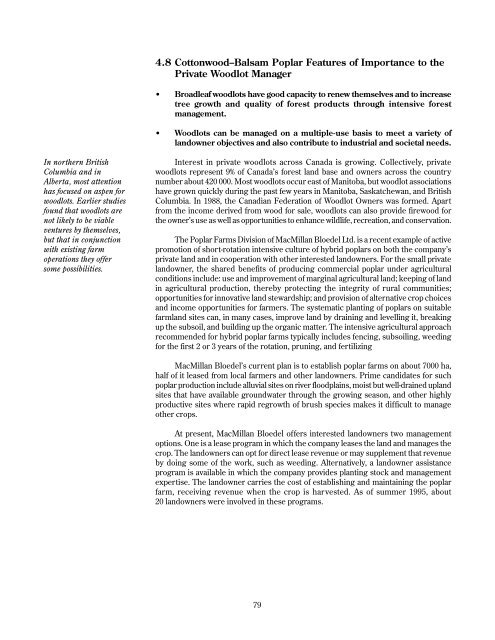FRDA Report: Black Cottonwood and Balsam Poplar Managers ...
FRDA Report: Black Cottonwood and Balsam Poplar Managers ...
FRDA Report: Black Cottonwood and Balsam Poplar Managers ...
Create successful ePaper yourself
Turn your PDF publications into a flip-book with our unique Google optimized e-Paper software.
In northern British<br />
Columbia <strong>and</strong> in<br />
Alberta, most attention<br />
has focused on aspen for<br />
woodlots. Earlier studies<br />
found that woodlots are<br />
not likely to be viable<br />
ventures by themselves,<br />
but that in conjunction<br />
with existing farm<br />
operations they offer<br />
some possibilities.<br />
4.8 <strong>Cottonwood</strong>–<strong>Balsam</strong> <strong>Poplar</strong> Features of Importance to the<br />
Private Woodlot Manager<br />
• Broadleaf woodlots have good capacity to renew themselves <strong>and</strong> to increase<br />
tree growth <strong>and</strong> quality of forest products through intensive forest<br />
management.<br />
• Woodlots can be managed on a multiple-use basis to meet a variety of<br />
l<strong>and</strong>owner objectives <strong>and</strong> also contribute to industrial <strong>and</strong> societal needs.<br />
Interest in private woodlots across Canada is growing. Collectively, private<br />
woodlots represent 9% of Canada’s forest l<strong>and</strong> base <strong>and</strong> owners across the country<br />
number about 420 000. Most woodlots occur east of Manitoba, but woodlot associations<br />
have grown quickly during the past few years in Manitoba, Saskatchewan, <strong>and</strong> British<br />
Columbia. In 1988, the Canadian Federation of Woodlot Owners was formed. Apart<br />
from the income derived from wood for sale, woodlots can also provide firewood for<br />
the owner’s use as well as opportunities to enhance wildlife, recreation, <strong>and</strong> conservation.<br />
The <strong>Poplar</strong> Farms Division of MacMillan Bloedel Ltd. is a recent example of active<br />
promotion of short-rotation intensive culture of hybrid poplars on both the company’s<br />
private l<strong>and</strong> <strong>and</strong> in cooperation with other interested l<strong>and</strong>owners. For the small private<br />
l<strong>and</strong>owner, the shared benefits of producing commercial poplar under agricultural<br />
conditions include: use <strong>and</strong> improvement of marginal agricultural l<strong>and</strong>; keeping of l<strong>and</strong><br />
in agricultural production, thereby protecting the integrity of rural communities;<br />
opportunities for innovative l<strong>and</strong> stewardship; <strong>and</strong> provision of alternative crop choices<br />
<strong>and</strong> income opportunities for farmers. The systematic planting of poplars on suitable<br />
farml<strong>and</strong> sites can, in many cases, improve l<strong>and</strong> by draining <strong>and</strong> levelling it, breaking<br />
up the subsoil, <strong>and</strong> building up the organic matter. The intensive agricultural approach<br />
recommended for hybrid poplar farms typically includes fencing, subsoiling, weeding<br />
for the first 2 or 3 years of the rotation, pruning, <strong>and</strong> fertilizing<br />
MacMillan Bloedel’s current plan is to establish poplar farms on about 7000 ha,<br />
half of it leased from local farmers <strong>and</strong> other l<strong>and</strong>owners. Prime c<strong>and</strong>idates for such<br />
poplar production include alluvial sites on river floodplains, moist but well-drained upl<strong>and</strong><br />
sites that have available groundwater through the growing season, <strong>and</strong> other highly<br />
productive sites where rapid regrowth of brush species makes it difficult to manage<br />
other crops.<br />
At present, MacMillan Bloedel offers interested l<strong>and</strong>owners two management<br />
options. One is a lease program in which the company leases the l<strong>and</strong> <strong>and</strong> manages the<br />
crop. The l<strong>and</strong>owners can opt for direct lease revenue or may supplement that revenue<br />
by doing some of the work, such as weeding. Alternatively, a l<strong>and</strong>owner assistance<br />
program is available in which the company provides planting stock <strong>and</strong> management<br />
expertise. The l<strong>and</strong>owner carries the cost of establishing <strong>and</strong> maintaining the poplar<br />
farm, receiving revenue when the crop is harvested. As of summer 1995, about<br />
20␣ l<strong>and</strong>owners were involved in these programs.<br />
79

















